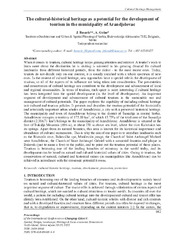Приказ основних података о документу
The cultural-historical heritage as a potential for the development of tourism in the municipality of Aranđelovac
| dc.creator | Basarić, Jelena | |
| dc.creator | Golac, Andrijana | |
| dc.date.accessioned | 2022-10-27T12:10:13Z | |
| dc.date.available | 2022-10-27T12:10:13Z | |
| dc.date.issued | 2022 | |
| dc.identifier.isbn | 978-618-84403-6-4 | |
| dc.identifier.issn | 2654-0460 | |
| dc.identifier.uri | http://raumplan.iaus.ac.rs/handle/123456789/660 | |
| dc.description.abstract | When it comes to tourism, cultural heritage keeps gaining attention and interest. A tourist’s wish to learn more about the destination he is visiting is mirrored in his growing demand for cultural landmarks from different historical periods, from the oldest - to the most recent ones. Today, tourists do not decide only on one content, it is usually enriched with a whole spectrum of new ones. In the context of cultural heritage, new approaches have a special role in the development of tourism, so all of the aspects of its influence are being taken into consideration. The presentation and conservation of cultural heritage can contribute to the development and advancement of local and regional communities. In terms of tourism, each space is more interesting if cultural heritage has been integrated into the spatial development (in the level of development). An important segment of development and advancement of cultural tourism is the sustainable use and management of cultural potentials. The paper explores the capability of including cultural heritage into cultural and tourism policies. It presents and describes the tourism potential of the historically and artistically important urban wholes of Aranđelovac, a city with a preserved historical heritage. The municipality and town of Aranđelovac belong to the district of Šumadija in central Serbia. Aranđelovac occupies a territory of 375.89 km2, of which 15.75% of the total area of the Šumadija district (2.386.71 km2) belongs to the municipality of Aranđelovac. Aranđelovac is situated at the foot of Bukulja Mountain (696 m), at about 250 m above sea level, where the river Kubršnica has its springs. Apart from its natural beauties, this area is known for its historical importance and abundance of cultural monuments. This is why the aim of our paper is to introduce landmarks such as the Risovača cave, Bukovička spa, Marićevića jaruga, the Church of Saint Archangel Michael near Aranđelovac, the Church of Saint Archangel Gabriel with a memorial fountain and plaque in Bukovik (just to name a few) to the public, and to point out the tourism potential of those places. Tourism is becoming one of the leading branches of economy in the world today, and its development can be based on natural and cultural-historical values of cities. Owing to tourism, the conservation of natural, cultural and historical values (in municipalities like Aranđelovac) can be achieved in accordance with the economic potential it owns. | sr |
| dc.language.iso | en | sr |
| dc.publisher | Volos : University of Thessaly, Department of Planning and Regional Development, Laboratory of Urban Morphology & Design, Volos, Greece | sr |
| dc.relation | info:eu-repo/grantAgreement/MESTD/inst-2020/200006/RS// | sr |
| dc.rights | openAccess | sr |
| dc.source | Proceedings of the International Conference on Changing Cities V: Spatial, Design, Landscape, Heritage & Socio-economic Dimensions Corfu Island, Greece, June 20-25, 2022 | sr |
| dc.subject | cultural-historic heritage | sr |
| dc.subject | tourism | sr |
| dc.subject | development | sr |
| dc.subject | promotion | sr |
| dc.subject | protection | sr |
| dc.title | The cultural-historical heritage as a potential for the development of tourism in the municipality of Aranđelovac | sr |
| dc.type | conferenceObject | sr |
| dc.rights.license | ARR | sr |
| dc.citation.spage | 942 | |
| dc.citation.epage | 952 | |
| dc.citation.rank | M33 | |
| dc.description.other | Editor: Aspa Gospodini | sr |
| dc.identifier.fulltext | http://raumplan.iaus.ac.rs/bitstream/id/2774/bitstream_2774.pdf | |
| dc.identifier.rcub | https://hdl.handle.net/21.15107/rcub_raumplan_660 | |
| dc.type.version | publishedVersion | sr |

